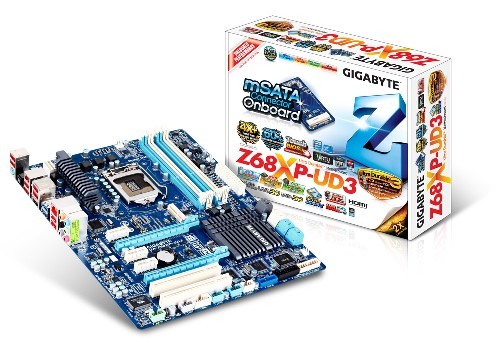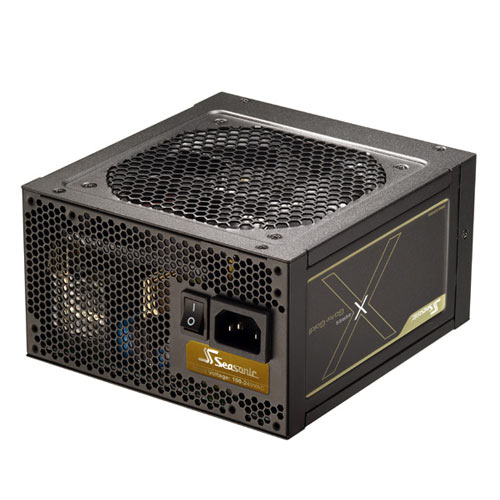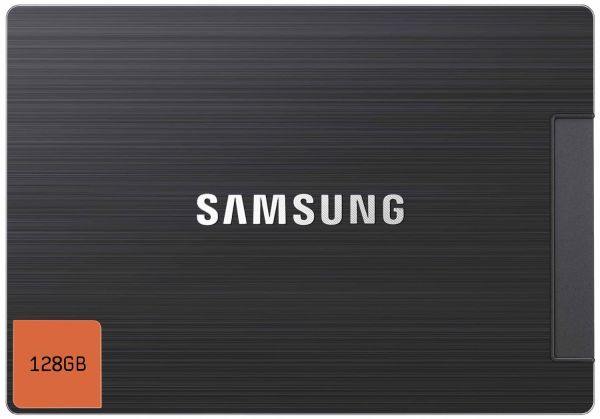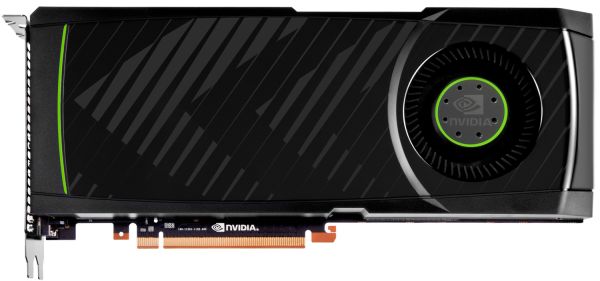Holiday 2011 Mainstream High-End Buyer's Guide
by Zach Throckmorton on December 9, 2011 12:00 AM EST- Posted in
- Guides
- AMD
- Intel
- Sandy Bridge
- CrossFire
- Sandy Bridge E
- Holiday 2011
- NVIDIA
Gamer's delight
While the HTPC on the previous page is designed for intensive video transcoding and therefore is built around a Intel Core i7-2600K with Hyper-Threading, this rig is devoted to gaming and therefore utilizes an Intel Core i5-2500K. You can see clearly from Bench that most games do not benefit from the 2600K's Hyper-Threading. Instead, it's a better idea to spend that $100 or so savings elsewhere if your primary consideration is gaming.
Because games do respond well to increased clockspeeds, and the Core i5-2500K is a multiplier unlocked CPU (so overclocking it is a breeze), we're recommending Corsair's H80 closed-loop CPU water cooler. All-in-one water-cooling kits like this Corsair are not only (generally speaking) great CPU coolers, they're also an easy introduction to more sophisticated water-cooling setups in case you're interested in exploring water-cooling at some point in the future. Jared recently reviewed the H60, H80, and H100—all of these fit in the Fractal Design Define R3 case we're recommending.

Gigabyte's GA-Z68XP-UD3 is an ATX form factor motherboard with all of the bells and whistles. It is a very capable overclocker and in my experience very reliable as well. While it's definitely not in the highest echelon of LGA 1155 motherboards, it is a solid higher-end mainstream motherboard. Perhaps of most interest to gamers, it supports both SLI and CrossFire—more on those in a moment.
Though not many current games benefit much from more than 8GB of DDR3, given the low prices of RAM and the larger budget, we're recommending two 8GB kits for 16GB total RAM. The G.SKILL Ripjaws X in the parts list below are great performers, but there are many other comparable kits.
Games don't always benefit much from an SSD, either, but again given the bigger budget, this build has a 128GB Samsung 830 Series SSD for its OS and application drive. That's enough space for plenty of both productivity and entertainment applications. I cannot stress enough how much general responsiveness and overall, day-to-day computing benefit from the addition of an SSD. Samsung's 830 Series drives are already developing a reputation for reliability, and as Anand found in his recent review, they also perform very well. In case your game—or media—library is very large (e.g. you play Rage!), the stalwart Samsung F3 1TB hard drive should be enough space for even the most prolific gamer.
The heart of any gaming rig is its GPU—or GPUs. The NVIDIA GTX 580 is the most powerful single GPU discrete video card available, and at $500, it's really pushing the envelope for "mainstream". You can see how it fares in Bench. The GTX 580 will play Crysis: Warhead at 1920x1200 resolution on gamer quality settings at an average of 60 frames per second. So, yes, it will run Crysis! But what if you're interested in SLI/CrossFire? $500 will buy one GTX 580—or two AMD Radeon HD 6950s. In general CrossFired 6950s outperform a single GTX 580, in some cases by a large margin. You can see how the two configurations compare on Bench. That said, I've yet to see a CrossFire (or SLI) setup that didn't have a few quirks—or downright aggravating issues. If you don't want to bother with SLI/CrossFire, the GTX 580 is your best bet (unless you want to plunk down even more money on a single card with dual GPUs, but I don't consider those much better than SLI/CF setups). If you are willing to put the additional time and effort into a CrossFire/SLI setup, you'll get a lot more bang for your buck with two Radeon HD 6950s.

SeaSonic's X850 is an extremely well-built 850W power supply capable of powering this impressive system whether you decide to go with a single GTX 580 or two Radeon HD 6950s. That said, the Bench test system hit 850W with two GTX 580s in SLI under Furmark—so if you plan to go with one GTX 580 initially and add a second card later, you will want to upgrade to a more powerful PSU. Finally, everything is housed in a Fractal Design Define R3. I recently recommended this case in the midrange buyer's guide and while there are other comparable cases like Corsair's 500R and Antec's P280, I like that the Fractal R3 is less expensive and, in my opinion, looks better.
| Component | Product | Price |
| CPU | Intel Core i5-2500K | $220 |
| CPU cooler | Corsair H80 | $94 |
| Motherboard | Gigabyte GA-Z68XP-UD3 ATX | $150 |
| RAM | (2) G.SKILL Ripjaws X 8GB (2x4GB) DDR3 1600 | $60 (total) |
| GPU | EVGA GeForce GTX 580 1536MB GDDR5 | $500 |
| GPU alternate | (2) XFX Radeon HD 6950 1GB GDDR5 | $500 (total) |
| SSD | Samsung 830 MZ-7PC128D/AM 128GB | $230 |
| HDD | Samsung Spinpoint F3 1TB | $150 |
| Power supply | SeaSonic X850 Gold 850W | $150 |
| Case | Fractal Design Define R3 | $110 |
| Optical drive | ASUS DRW-24B1ST/BLK/B/AS | $19 |
| Operating system | Microsoft Windows 7 Home Premium 64-bit (OEM) | $100 |
| Total: | $1783 | |
Next up, we're sacrificing graphics capability/gameplay ability for raw CPU speed. If you want an incredibly powerful computer, check the next page.












52 Comments
View All Comments
piroroadkill - Friday, December 9, 2011 - link
Mine's pretty similar :3i5-2500K
Asus P8Z68-V Pro
Corsair A70
Seasonic X-660
Fractal Design Define R3
8GB Patriot G2
Also, MSI Twin Frozr III Radeon 6950 (which unlocked to 1536 shaders)
87_heavyboy - Friday, December 9, 2011 - link
The ASRock Z68M-ITX/HT looks nice at first glance, so I bought it, too. Together with the i7 2600K. I also thought "great, m-ITX + overclocking - something for the future". In practice, it has its problems. The mosfets don't have coolers on them, they get hot quite fast, resulting in throttling. The board can't hold 3.4 GHz for some minutes during compilation :( I did not even think about overclocking!The other problem: It supports Overclocking but no undervolting. SNB comes with quite defensive default-voltage, resulting in good undervolting-potential.
Positive:
It pulls just ~30W at idle.
I think, it would have been a better choice to go mATX, if it should be a smaller PC.
duploxxx - Friday, December 9, 2011 - link
this HTPC design is a huge waste of moneyMrTeal - Friday, December 9, 2011 - link
I was curious about that too.My HTPC is a low power, quiet affair with an X3, a modded and silent 5570 and an SSD, no mechanical HDD. Any encoding I do on my main rig so that my HTPC stays low power and silent, and just stream the data over the network.
Do many people really build powerful and expensive HTPCs? I find usingmine as a PC @ 1080p/47" is kind of a poor experience when you're sitting at normal TV viewing distances, so all I really use mine for is a media streamer and checking scores / watching Youtube. Any real computing I just do at my desktop. I'd be interested in how other people use these HTPCs.
Z Throckmorton - Friday, December 9, 2011 - link
Generally speaking, an AMD E-350 setup is sufficient for the majority of HTPC usage scenarios. However, I have built a few more powerful HTPCs for people who want to transcode video but don't want their primary home computer tasked as a video editor, and don't want to bother with a LAN.Death666Angel - Friday, December 9, 2011 - link
That is bollocks. They clearly state they are not going with a traditional HTPC setup (i.e. just be able to play back everything). They want performance for coding, HDTV streaming capabilities and storage as well. If people are in the market for that and have the cash, there is nothing I would really see being done to bring down the price while maintaining the performance.I personally have a small media client and a large file server in the back and I'm not interested in HDTV stuff. I came away spending about 400€.
piroroadkill - Friday, December 9, 2011 - link
I wouldn't recommend them, anymore. I've seen my 2GB Radeon 6950 use more than 1GB with GPU-Z open on another screen. For the slight extra cost, and the chance of unlocking (mine did, and it's not so old), 2GB 6950 all the way, all the time.prdola0 - Friday, December 9, 2011 - link
Zach, wouldn't it be better to use 2x non-reference GTX560Ti in SLI instead of 2x HD6950? There is quite a lot of GTX560Ti models clocked ~15% higher than the reference card, which matches even the HD6970 performance. They are both more price-efficient than HD6950 and also SLI tends to be more stable (you usually don't see negative scaling and similar problems). Of course there is also the added value of Nvidia actually supporting gamers, unlike AMD. The Skyrim graphics setup guide they just recently released is simply great and most other GeForce.com articles are helpful just as much.Take care,
Prdola
Death666Angel - Friday, December 9, 2011 - link
Hm....According to the bench, SLI 560TI and CF HD6950 trade blows the whole time except for Civ5 where nVidia clearly wins or anything above 1920x1200 where AMD clearly wins.
If you go with SLI/CF, gaming at 1920x1200 is moronic anyway, so I think it is very valid to recommend HD6950 over the 560TI. Also, most recent reviews of CF/SLI I have seen have them nearly on par, with nVidia leading in a few games and AMD in others. It is not a situation like two years ago where nVidia had a clear lead. And speaking for my market, there really is no difference between HD6950 and 560TI cards. You can find both at pretty much the same price points.
So, to summarize: to each his own, every company has great cards for good prices. Look at your usage pattern and a special deal, then decide. :-)
prdola0 - Monday, December 12, 2011 - link
That's hardly so. I am talking about overclocked editions of GTX560Ti. In this regard the GTX560Ti is almost as easily over-clockable as GTX460 was. And there are almost as many 560Ti non-reference OC models. And those editions trade blows with HD6970, yet are priced at HD6950 mark or some between HD6950 and HD6970.